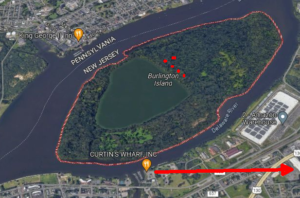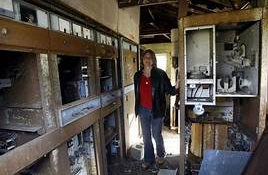Don’t F— It Up!

By Bruce Schiller
[July 2023] This story is a good example of the way we broadcasters often have to troubleshoot and fix problems, both in work and in life. The deal is: fix all the stages of a problem, one by one, until it all works!
I am sure every radio engineer has had to troubleshoot air failures and sometimes discover multiple problems – some not even technical problems. This is my story.
In the late 60s, I had worked at my college station, WGLS-FM, Glassboro State College, NJ, then went to CCA Electronics as the “Hippie Shipper” – in charge of packing new transmitters in wooden crates and boxing up lots of spare parts, consoles, etc. Then I finally got my First Phone and started working at WJJZ, Mt. Holly, NJ.
This story is about what happened to me in 1971 at WJJZ, a 5 kW, four-tower AM daytimer on 1460, with a transmitter site on Burlington Island – as it turned out, not the most easily accessible place.
FIRST PHONE AND PROGRAM DIRECTOR
At WJJZ a daily air shift and the daily remote inspections at the transmitter site, located on Burlington Island.
Since it was a daytimer, WJJZ was only on the air for about 10 and 1/2 hours a day during the short December days, so the GM laid off the non-technical Program Director, and I became both the engineer and the new PD – but actually the General Manager did the morning show, sold spots, and made all the decisions.
To give you an idea of the times, I was making $110 a week the whole time I worked there, from 1970 to 1972, 2 and 1/2 years.
WHEN THE STAFF WAS JUST ME
It was the summer of 1971. The station owner was at his vacation house in Florida, and the General Manager was heading to the shore at Ocean City, NJ, for the weekend – about 100 miles or so from the station.
I would be completely in charge! To make sure I knew who was really in charge, GM gave me explicit instructions, “Don’t F— this up!!!!!”
So it was that I arrived at the studio in Mt. Holly Sunday morning at 5:45 AM and remotely turned on the 5 kW Gates BC5P2 transmitter, letting the Mercury Vapor Rectifier tubes warm up for five minutes or so before turning on the High Voltage at 6 AM.
The carrier came up all right, but when I played the sign-on cart, there was no audio on the air!
URGENT TROUBLESHOOTING
I took my headphones and alligator clips and connected them to the terminals where the dedicated phone line that carried the program audio from the studio to the transmitter left the building.
In the headphones, I could hear the program audio loud and clear. The problem was not there at the studio, and it was somewhere downstream.
With no audio on the air, there were no commercials. All I could hear was the Manager’s voice in my head, “Don’t F— this up!!!!!”.
OUT THE DOOR
Since Gary, a fellow who was to be doing the daily required transmitter inspection that day, would not be at the transmitter until just before 8 AM, I figured I had better head out to Burlington Island and see what was up at the transmitter.
I got in my car, a 1964 MG convertible, and pulled out of the parking lot.
And … thunk….. thunk….. thunk….. thunk. Oh, No!!! What a time for a flat tire!!!!
MECHANICAL REPAIR
There was nothing to do but stop at the traffic light in the left turn lane around the corner from the studio.
Yes, it was the left turn lane, but there was no traffic at all; remember, it was 6 AM Sunday morning. I got out, grabbed my mallet and spare tire out of the trunk, and quickly knocked off the MG center hubcap and changed the tire, completing the job in only two cycles of the traffic signal light – and then I headed towards Burlington Island.
ANOTHER SMALL ROADBLOCK
The transmitter site was on Burlington Island, an island in the Delaware River, with no bridge to get over there.


WJJZ owned a 16-foot aluminum boat with a 9.8 Horsepower tiller-drive outboard motor to get us over there. The boat was docked at Curtin’s Marina in Burlington City. The normal procedure was to get the boat and go around the island to the Pennsylvania side, where there was an entrance to what was an old water-filled gravel pit, the Burlington Island Lake, which left only a few hundred feet to walk to get to the transmitter.
But that day, it was not going to be so easy.
WHAT ELSE COULD GO WRONG?
As quickly as I could, I parked at Curtin’s Marina and went down onto the dock where our boat was moored. But it was not there! Oh noooooooo!
Then I noticed the two cleats where our boat would have been tied had halters tied to them. Our boat had sunk but was still tied to the dock, hanging on the side of the wharf under the water!
What could I do now? All I could remember was, “Don’t F— this up!!!!!” still sounding in my head.
No one from Curtin’s Marina would be showing up until later, so there was only one thing I could do.
I put my wallet under the seat in my MG, walked down to the end of the dock, took off my shoes, and jumped into the Delaware River, swimming 400 feet over to Burlington Island. Then I had to walk about 3/4 of a mile to the transmitter shack.
AT LEAST ONE QUICK RESOLUTION
Luckily, it only took about 15 seconds to realize that the fuse on the CBS Audimax audio processor was blown.
I put in a new fuse, and the Audimax came back to life.
Since one of the newsmen would soon be showing up at the studio, I called him and had him sign on and start doing the morning show. WJJZ was back on the air at about 7:30 AM – only an hour and a half late!
All in all, I modestly felt we had managed success!
RETRACING STEPS
As long as I was there, I did the required daily remote transmitter inspection, walked back the 3/4 of a mile, and swam back to Curtin’s Marina, where I ran into Gary waiting for me.
He had seen my pair of shoes sitting on the end of the dock and guessed that I had swum over to the island.
Then I drove back to the studio and finished my air shift!!!
HISTORY
WJJZ lost its license in 1982 and went off the air.
The 4-tower inline array was there for 10 or 15 years later, but now it has been torn down. I was out on the island about a year or so ago, and there is no sign of the former tower bases or the tower base tuning huts. In fact, the antenna field is so overgrown you cannot even tell where the towers had been. Only the transmitter hut is left, with the remains of the transmitter.

Among the last visitors to the former WJJZ site found little but the decaying remains of the transmitter and phasor.
Conservation laws now prevent people from visiting the island at all.
However, as we look back at that morning at WJJZ, the GM was pleased with my dogged efforts to get to the transmitter and get it on the air.
And you know what? I am certain I had not f—‘d anything up at all!
– – –
Bruce “Brew” Schiller retired after 30 years at the CBS-TV Broadcast Center in New York City. You can reach him at brew@themode.com
–
– – –
Would you like to know when more articles like this are published? It will take only 30 seconds to
click here and add your name to our secure one-time-a-week Newsletter list.
– – –
